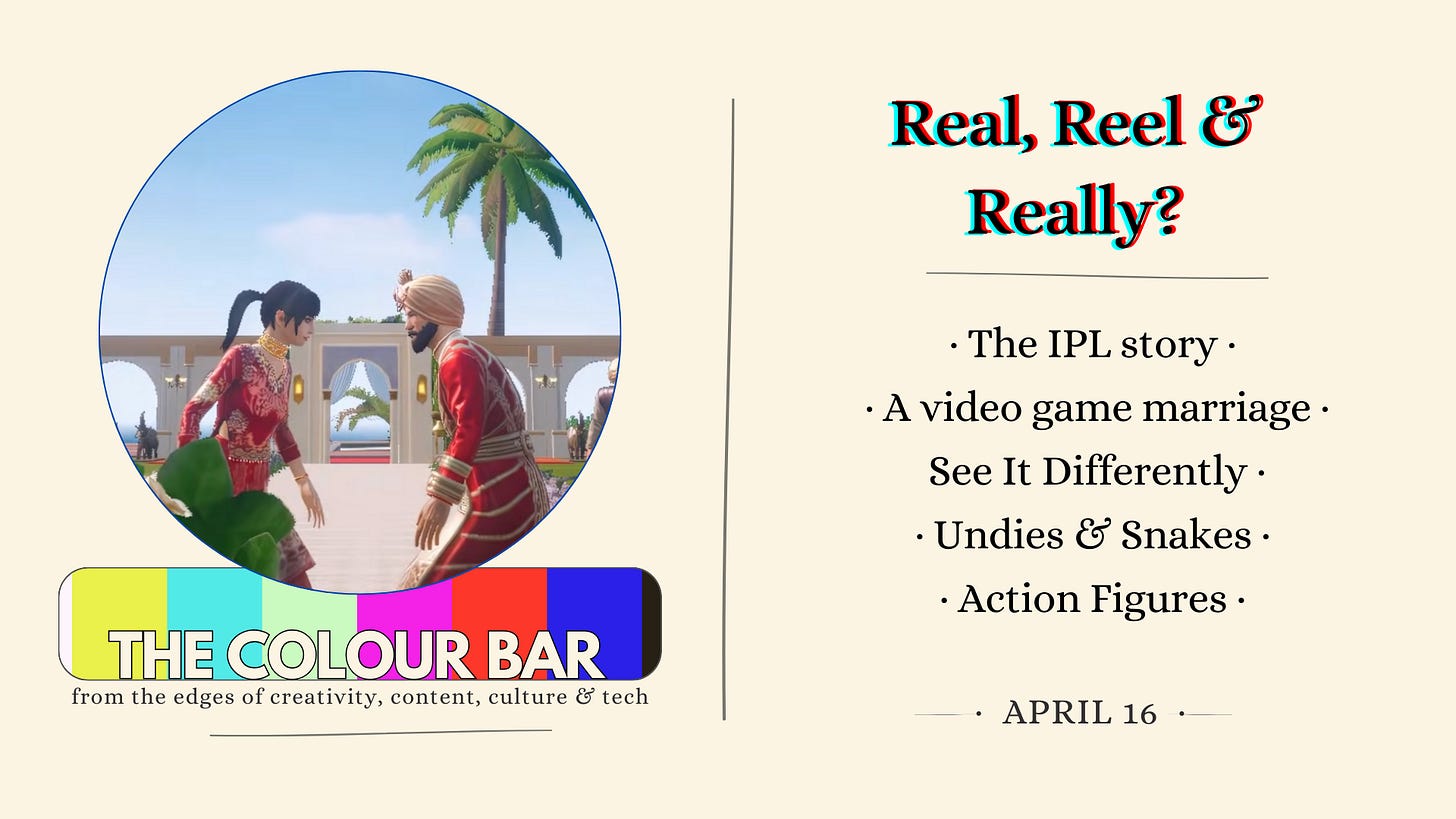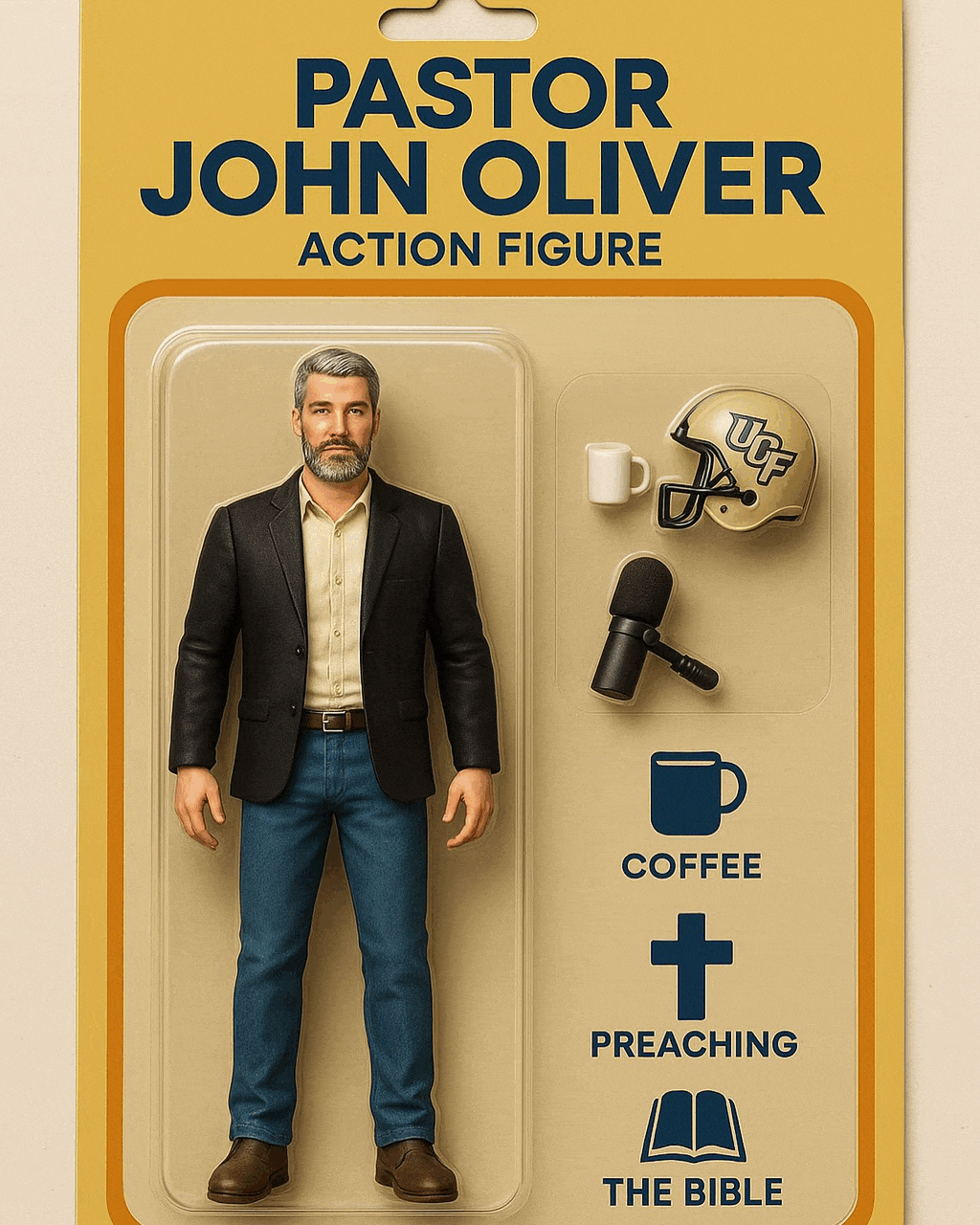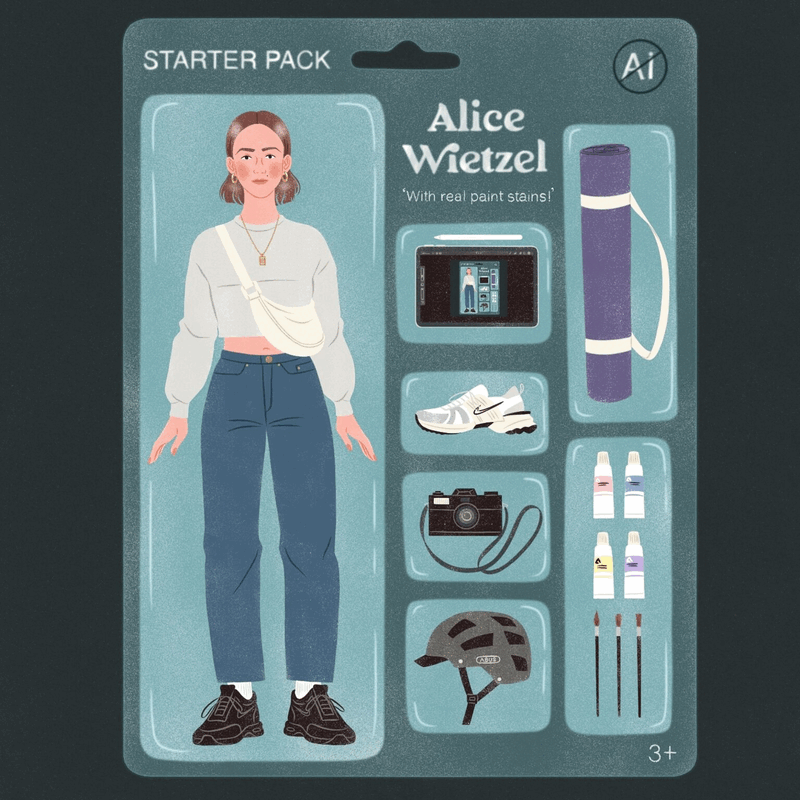Real, Reel & Really?
· the IPL story · a video game marriage · see it differently · action figures ·
This is the Colour Bar- where creativity, content, culture, tech, brands & humanity collide.
Today that collision yields a wonderful podcast on the IPL, a stunning showcase of filmmaking craft from Britbox, a video game marriage, those action figures you don’t want to see anymore of (but you should see what I have here!), and much, much more.
▶️ Curated/Cuts watches in wonder as 14 incredible hours converge into seconds, stares at underwear and snakes, and celebrates nuptials that straddle a game and reality.
➕ Quickies on Nintendo, short form for streamers, a British SNL, the creator economy and Netflix 🤝🏻 OpenAI.
The IPL story
A couple of weeks ago, a podcast link rapidly did the rounds on my Whatsapp. It blazed through cricket groups, TV connections, media folks, sports lifers, and others on the fringes of all of these. It was Acquired’s epic story of the Indian Premier League, the flashiest and most successful franchise tournament in cricket.
Described by the WSJ as "the business world’s favourite podcast”, Acquired tells the stories and strategies of great companies. With episodes ranging 3-4 hours long, it calls itself a ‘depth-first show’, one that is reaches a million listeners every edition.
Few weeks ago, it dropped a mammoth look at the IPL. For just shy of 4.5 hours, hosts Ben Gilbert and David Rosenthal dive into the story of what they call the “most dynamic and most disruptive force in the sports industry today.”
“if you were to design a sports league to maximise the bottom line, this is how you would do it.”
From the mid 90s through to spring of 2025, this is not merely the analysis of a sports league coming to life. It is the diligent exploration of corporate drama; a captivation with the intrigue that shaped both Indian cricket and the wider sport itself; a helplessly gleeful fascination with the machinations of key players. Most of all, Lalit Modi.
It is presented very much as Lalit Modi’s brainchild, and constantly returns to what they unerringly believe is his central role in both revolutionising a sport, and the media industry around it. His tussle with Rupert Murdoch and his power play with broadcasting, are recurring themes.
“The story itself has just about the most palace intrigue of any company we've ever studied. There's corruption, there's potential self-dealing, betting, rigging, and miraculously, the league has been successful despite all that.”
Most striking is the point made early on, one that will ring true with many who might have followed or been on the fringes of this in the last two decades or so.
“it seems like every element of this has two completely different sides to the story, both of which the leaders of that side dig in and maintain their side. In most companies we study, there kind of becomes one canonical truth, and it's mostly written by the victors. But in the history of the IPL, and especially with Lalit Modi, there's always two completely different stories representing how it went, and nobody ever gives an inch on either side of them.”
There are no talking heads or guests, but the research is exhaustive and wide-reaching. And, I must add, for two (or more accurately, 1.5) Americans, their narrative around cricket is robust, absorbing, and- refreshingly- excited.
If I were to nitpick, and I suppose I must, it is the relative neglect rendered to two things. One, the wider arc of cricket’s journey in this time which, while heavily influenced by India’s own evolution, does merit consideration. Second, and more relevant to this analysis, is the role national teams play, as does the sport’s governing body, the ICC. Indeed, this dynamic is relatively unique in all sport, given how it is at the very heart of the game. A dynamic that still wields a powerful hold and emotive resonance, both of which provide guardrails for the growing power of a league like IPL and the fundamental changes it represents.
This story is many things at different points in time, but it is always riveting. For me and many I know, this arc overlaps our personal and professional trajectories; as cricket fans, as those who worked in sports, sports broadcasting, entertainment and beyond. It also rings true because we all understand,
“The stories are so divergent that it's impossible to know. There's no reconciling. There's no truth that is converged upon.”
Listen to the podcast here, finding your own episodic cadence!
🎬 Curated/Cuts.
1. See It Differently
An incredible showcase of film craft here. This is a spot that embraces the very effort which brings us entertainment we love; celebrating the human endeavour itself, as the reason to watch. The work is the message, if you will.
“One actor. 11 sets. 50 crew. No AI.” : ‘See It Differently’ is a spot from Britbox, the British streamer moving into the US.
As stop-motion marvel, this is one eye-catching continuous sequence, filmed over 14+ hours, with one actor, 11 different sets, 4 different genres, 50 crew members, 10 make-up artists and wardrobe stylists. Now that you know it, watch it again.
“A love letter to production craft and the brilliance of film crews,” the “No AI” in the the blurbs is a statement too. In showcasing craftsmanship, this looks to be an antidote to the flood of AI-generated imagery.
“In an era of AI automation, BritBox wanted to show there’s still value in craft and doing things for real,” said Sam Walker of Uncommon.
The ’How They Did It’ video is a great watch too. So much to look out for. :
· Directed by Nicos Livesy · Uncommon Studio · Blinkink · Millenium FX · Soundtree ·
2. Bonds Undies!
Aussie underwear brand Bonds embarks on a launch in the USA. It happily leans into cliches if laid-back Aussies and dangerous creatures.
commentary: https://www.marketingweek.com/ritson-bonds-local-brand-global-market/
3. The Great Indian (Gaming) Wedding.
BGMI (the most popular game in India), orchestrated two players getting married. In-Game. This is the legit, grand, elaborate Great Indian Wedding of Jaspreet & Tanupreet, a couple who first met while playing BGMI. Its really the whole shebang, with real life embedding of game elements (think invitations, decorations and more), all the way to In-Game Mehendi, Sangeet, and the Grand Shaadi.
Check out the epic wedding of OnFire X Hades and OnFire X Veronica!
Some quick hits before a few more stories.
➕Quickies
Indonesian animated feature Jumbo has become the highest-grossing Southeast Asian animation of all time; in Indonesia its crossed Moana 2. Crafted over five years by more than 420 Indonesian artists, animators, and storytellers, Jumbo follows Don, “an orphan bullied as “Jumbo” due to his large body. He has a storybook, inherited from his parents, full of drawings and magical stories. Don later encounters Meri, a fairy seeking his help to reunite her with her family.”
SNL, a cornerstone of US TV and comedy, will finally have a UK version in 2026. Sky announced it this week though it comes around three years after we first heard of the remake being on the cards. Whehere it can reach heights anything like the US remains to be seen in a culturally similar yet comedically distinct market. SNL has previoulsy been remade in Germany, Italy, South Korea and, if you believe it, China.
YouTube offers free AI music-maker to creators. Another example of moving to the median, as too many don’t care if the music is good, or just ok. Just ok= good enough has been percolating across sectors; its fast going to become the new norm, as mass gen-AI content proliferates.
Meanwhile Jim Louderback warns players in the creator economy to prepare for a winter, driven by market uncertainties, tariff wars, tightening of purse strings and reduced ad spend. “Strategy matters. Those who simplify, automate, and stay audience-first will be the ones still standing in 2027 and beyond.”
Netflix is testing an AI model to help viewers search for shows & movies, working with OpenAI. Discoverability continues to be at the centre of engagement.
Media’s need for short form
A case for Shorts & Reel-esque content being the new EPGs or discovery tools. This in itslef is not new, but I suspect the question that remains as yet unanswered is moving from discovery to actual viewing. In-app shorts is often seen as a strong option to bridge that gap- clearly you can move short form delight to watchlist and streaming a show with much less friction. Yet it comes with its own challenge- you still need to build a viewing habit on your own app, a habit that is entirely owned by platforms like Youtube & Tiktok. Paul Pastor asserts here that companies not investing in this are courting long term failure.
The piece touches upon a study “showing that nearly 71 percent of Gen Z consumers discover content through social platforms. So, it’s no wonder media companies are actively investing in a shorts strategy in their apps to surface new and long tail content, in the hope that consumers engage, bookmark, or click to start watching.”
The key word there? Hope.
Nintendo
‘The Nintendo has moved beyond specs’. Andrew Webster outlines how Nintendo has carved out a path where specs no longer matter. This comes in the wake of its recent Switch 2 announcement, which was shorn of any real tech or under the hood details, but generated excitement nonetheless.
Yet- as with much- if you delve a bit more, it appears this might well not be a new thing for Nintendo. (I can’t claim deep understanding of Nintendo’s tech arc!). So a dive into the discussion around it yields:
“Gunpei Yokoi who created the Game and Watch which was first released in 1980 pioneered the concept of "Lateral Thinking with Withered Technology" when he took an old chip to create the Game and Watch. Since then Nintendo has tended to stick pretty close to that philosophy.“ _from Dr Calhoun
Nintendo hasn’t been concerned with specs since the GameBoy or even the SNES. … The N64 and GC are the exception, not the rule. And they learned a hard lesson from that. _from BabaYagaWagaLaba
The one with action figures
We unequivocally live in a time where personal identity has become a product. ‘Personal branding’ is bandied about in some context or another, week after week. We all must have a personal brand. Because at the end of the day, we are all selling something. Yes,. Ok. Thank you. We get it.
The latest AI-trend aka Ver.1168724921 of “lets consume incredible amount of resources for some social media fun!”, was to use Chat GPT to create ‘action figures’. Of oneself. (Or, hey, of anyone else too, because copyright, what image copyright?).
People scrambled on to the bandwagon, and you can kinda see why. It seems harmless, seems less obviously egregious from an ethical POV, to most. Some call it harmless play. Some are annoyed the trend made its way on to a professional platform like Linkedin. Others see it as a mirror of a culture obsessed with packaging ourselves for attention.
But hey, its cute. So there’s that.
Here is a GIF so you know what we are on about.
A couple of takes:
“The bar moves ever lower as we limbo endlessly into the night.” _Nick Moran
“feels like an apt metaphor for how we’ve transformed from the creators to the consumers and now, finally, to the consumed, our bodies processed and packaged up by a capitalist system which knows only unbridled growth at any cost.” Threads user _mystgalaxybooks
Cutely and pointedly, many artists have decided to protest by appropriating these trends in the best possible way: by drawing, and in some cases, DIYing these ‘starter packs’ with real life selves!
The interesting, quirky, sincere, fun and random creations of such pushbacks to AI, are some of the most fascinating aspects of this influx of AI content.
If you really want to get into what this says about humanity, you could always go that cheery Marx fellow. As Mark Ritson did. “One of the many things that Marx correctly predicted was that the process of commodification– of turning something into a sellable good– would only be complete when people within society started to make commodities of themselves. His prediction of the ‘commodification of self’, made more than a century ago, has proven prophetic.”
Or then, there’s this quote from Erich Fromm in his book written 70 years ago!
“Modern man has transformed himself into a commodity; he experiences his life energy as an investment with which he should make the highest profit, considering his position and the situation on the personality market. He is alienated from himself, from his fellow men and from nature. His main aim is profitable exchange of his skills, knowledge, and of himself, his "personality package" with others who are equally intent on a fair and profitable exchange. Life has no goal except the one to move, no principle except the one of fair exchange, no satisfaction except the one to consume.”
Related? “The viral Ghibli images produced by ChatGPT are not made with malice aforethought, but they represent the worst bits of AI-produced media.” The Studio Ghibli generator goes against everything I love about those movies.
“there’s still value in craft and doing things for real,” _Sam Walker, Uncommon.







